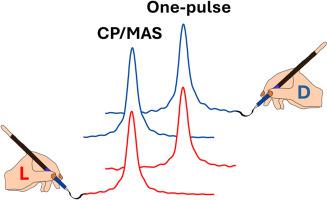当前位置:
X-MOL 学术
›
Solid State Nucl. Magn. Reson.
›
论文详情
Our official English website, www.x-mol.net, welcomes your
feedback! (Note: you will need to create a separate account there.)
Solid-state NMR spectra of amino acid enantiomers and their relative intensities
Solid State Nuclear Magnetic Resonance ( IF 1.8 ) Pub Date : 2024-04-01 , DOI: 10.1016/j.ssnmr.2024.101925 Audrey-Anne Lafrance 1 , Manon Girard 1 , David L Bryce 1
Solid State Nuclear Magnetic Resonance ( IF 1.8 ) Pub Date : 2024-04-01 , DOI: 10.1016/j.ssnmr.2024.101925 Audrey-Anne Lafrance 1 , Manon Girard 1 , David L Bryce 1
Affiliation

|
Under normal experimental conditions in an achiral environment, NMR spectra of enantiomers have chemical shifts and couplings which are not differentiable. In this work, the reproducibility of spectral intensities for pairs of amino acid enantiomers, as well as factors influencing these intensities, is assessed using C and N cross-polarization magic-angle spinning (CP/MAS) NMR spectroscopy. Prompted by a recent literature debate over a possible influence of the chirality-induced spin selectivity (CISS) effect on spectral intensities obtained in CP/MAS NMR experiments carried out on enantiomers, a number of control experiments were performed with recycle delays of at least 5. These included the analysis of proton-decoupled Bloch decay solid-state NMR spectra as well as solution NMR spectra where the cross polarization process is absent. Bloch decay and CP/MAS NMR spectra yield the same relative intensities for pairs of enantiomers while solution NMR spectra provide relative intensities closest to unity. Differences of plus-or-minus a few percent in the D/L spectral intensity ratios observed in all solid-state NMR experiments are due to sample preparation (i.e., grinding, particle size, partial amorphization) and limitations on sample purity. As previously described in the literature, more drastic intensity differences on the order of 50% are easily created by ball milling the samples. Finally, apodization is shown to invert the apparent D/L ratio in low signal-to-noise N CP/MAS NMR spectra of aspartic acid enantiomers. In summary, no spectral intensity differences attributable to enantiomerism are identified.
中文翻译:

氨基酸对映体的固态核磁共振谱及其相对强度
在非手性环境中的正常实验条件下,对映体的核磁共振谱具有不可微分的化学位移和耦合。在这项工作中,使用 C 和 N 交叉偏振魔角旋转 (CP/MAS) NMR 光谱评估了氨基酸对映体对光谱强度的再现性以及影响这些强度的因素。最近关于手性诱导自旋选择性 (CISS) 效应对对映异构体进行 CP/MAS NMR 实验中获得的光谱强度可能产生影响的文献争论促使我们进行了一些控制实验,循环延迟至少为 5其中包括质子解耦布洛赫衰变固态核磁共振谱以及不存在交叉极化过程的溶液核磁共振谱的分析。布洛赫衰变和 CP/MAS NMR 谱对于对映体对产生相同的相对强度,而溶液 NMR 谱提供最接近统一的相对强度。在所有固态 NMR 实验中观察到的 D/L 光谱强度比正负几个百分点的差异是由于样品制备(即研磨、粒径、部分非晶化)和样品纯度的限制造成的。正如之前的文献所述,通过球磨样品很容易产生 50% 左右的更剧烈的强度差异。最后,变迹可反转天冬氨酸对映体的低信噪 N CP/MAS NMR 谱中的表观 D/L 比。总之,没有发现对映体造成的光谱强度差异。
更新日期:2024-04-01
中文翻译:

氨基酸对映体的固态核磁共振谱及其相对强度
在非手性环境中的正常实验条件下,对映体的核磁共振谱具有不可微分的化学位移和耦合。在这项工作中,使用 C 和 N 交叉偏振魔角旋转 (CP/MAS) NMR 光谱评估了氨基酸对映体对光谱强度的再现性以及影响这些强度的因素。最近关于手性诱导自旋选择性 (CISS) 效应对对映异构体进行 CP/MAS NMR 实验中获得的光谱强度可能产生影响的文献争论促使我们进行了一些控制实验,循环延迟至少为 5其中包括质子解耦布洛赫衰变固态核磁共振谱以及不存在交叉极化过程的溶液核磁共振谱的分析。布洛赫衰变和 CP/MAS NMR 谱对于对映体对产生相同的相对强度,而溶液 NMR 谱提供最接近统一的相对强度。在所有固态 NMR 实验中观察到的 D/L 光谱强度比正负几个百分点的差异是由于样品制备(即研磨、粒径、部分非晶化)和样品纯度的限制造成的。正如之前的文献所述,通过球磨样品很容易产生 50% 左右的更剧烈的强度差异。最后,变迹可反转天冬氨酸对映体的低信噪 N CP/MAS NMR 谱中的表观 D/L 比。总之,没有发现对映体造成的光谱强度差异。






























 京公网安备 11010802027423号
京公网安备 11010802027423号